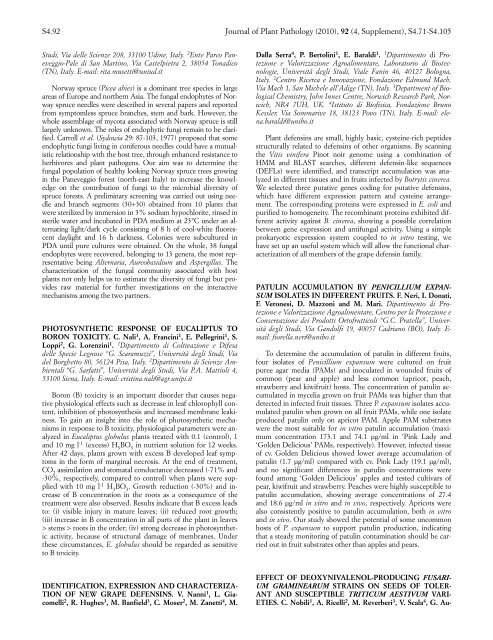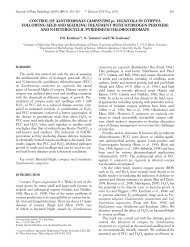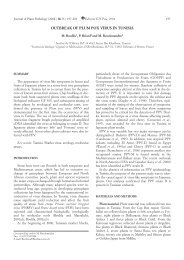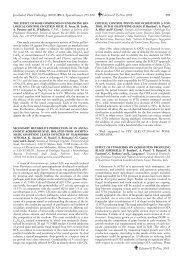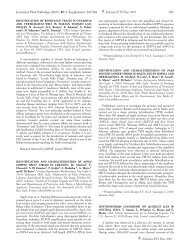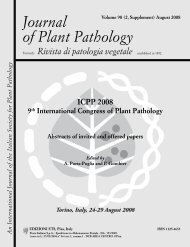Journal of Plant Pathology (2010), 92 (4, Supplement ... - Sipav.org
Journal of Plant Pathology (2010), 92 (4, Supplement ... - Sipav.org
Journal of Plant Pathology (2010), 92 (4, Supplement ... - Sipav.org
Create successful ePaper yourself
Turn your PDF publications into a flip-book with our unique Google optimized e-Paper software.
S4.<strong>92</strong> <strong>Journal</strong> <strong>of</strong> <strong>Plant</strong> <strong>Pathology</strong> (<strong>2010</strong>), <strong>92</strong> (4, <strong>Supplement</strong>), S4.71-S4.105<br />
Studi, Via delle Scienze 208, 33100 Udine, Italy. 2 Ente Parco Paneveggio-Pale<br />
di San Martino, Via Castelpietra 2, 38054 Tonadico<br />
(TN), Italy. E-mail: rita.musetti@uniud.it<br />
Norway spruce (Picea abies) is a dominant tree species in large<br />
areas <strong>of</strong> Europe and northern Asia. The fungal endophytes <strong>of</strong> Norway<br />
spruce needles were described in several papers and reported<br />
from symptomless spruce branches, stem and bark. However, the<br />
whole assemblage <strong>of</strong> mycota associated with Norway spruce is still<br />
largely unknown. The roles <strong>of</strong> endophytic fungi remain to be clarified.<br />
Carroll et al. (Sydowia 29: 87-103, 1977) proposed that some<br />
endophytic fungi living in coniferous needles could have a mutualistic<br />
relationship with the host tree, through enhanced resistance to<br />
herbivores and plant pathogens. Our aim was to determine the<br />
fungal population <strong>of</strong> healthy looking Norway spruce trees growing<br />
in the Paneveggio forest (north-east Italy) to increase the knowledge<br />
on the contribution <strong>of</strong> fungi to the microbial diversity <strong>of</strong><br />
spruce forests. A preliminary screening was carried out using needle<br />
and branch segments (30+30) obtained from 10 plants that<br />
were sterilized by immersion in 3% sodium hypochlorite, rinsed in<br />
sterile water and incubated in PDA medium at 23°C under an alternating<br />
light/dark cycle consisting <strong>of</strong> 8 h <strong>of</strong> cool-white fluorescent<br />
daylight and 16 h darkness. Colonies were subcultured in<br />
PDA until pure cultures were obtained. On the whole, 38 fungal<br />
endophytes were recovered, belonging to 13 genera, the most representative<br />
being Alternaria, Aureobasidium and Aspergillus. The<br />
characterization <strong>of</strong> the fungal community associated with host<br />
plants not only helps us to estimate the diversity <strong>of</strong> fungi but provides<br />
raw material for further investigations on the interactive<br />
mechanisms among the two partners.<br />
PHOTOSYNTHETIC RESPONSE OF EUCALIPTUS TO<br />
BORON TOXICITY. C. Nali 1 , A. Francini 1 , E. Pellegrini 1 , S.<br />
Loppi 2 , G. Lorenzini 1 . 1 Dipartimento di Coltivazione e Difesa<br />
delle Specie Legnose “G. Scaramuzzi”, Università degli Studi, Via<br />
del B<strong>org</strong>hetto 80, 56124 Pisa, Italy. 2 Dipartimento di Scienze Ambientali<br />
“G. Sarfatti”, Università degli Studi, Via P.A. Mattioli 4,<br />
53100 Siena, Italy. E-mail: cristina.nali@agr.unipi.it<br />
Boron (B) toxicity is an important disorder that causes negative<br />
physiological effects such as decrease in leaf chlorophyll content,<br />
inhibition <strong>of</strong> photosynthesis and increased membrane leakiness.<br />
To gain an insight into the role <strong>of</strong> photosynthetic mechanisms<br />
in response to B toxicity, physiological parameters were analyzed<br />
in Eucaliptus globulus plants treated with 0.1 (control), 1<br />
and 10 mg l -1 (excess) H 3 BO 3 in nutrient solution for 12 weeks.<br />
After 42 days, plants grown with excess B developed leaf symptoms<br />
in the form <strong>of</strong> marginal necrosis. At the end <strong>of</strong> treatment,<br />
CO 2 assimilation and stomatal conductance decreased (-71% and<br />
-30%, respectively, compared to control) when plants were supplied<br />
with 10 mg l -1 H 3 BO 3 . Growth reduction (-30%) and increase<br />
<strong>of</strong> B concentration in the roots as a consequence <strong>of</strong> the<br />
treatment were also observed. Results indicate that B excess leads<br />
to: (i) visible injury in mature leaves; (ii) reduced root growth;<br />
(iii) increase in B concentration in all parts <strong>of</strong> the plant in leaves<br />
> stems > roots in the order; (iv) strong decrease in photosynthetic<br />
activity, because <strong>of</strong> structural damage <strong>of</strong> membranes. Under<br />
these circumstances, E. globulus should be regarded as sensitive<br />
to B toxicity.<br />
IDENTIFICATION, EXPRESSION AND CHARACTERIZA-<br />
TION OF NEW GRAPE DEFENSINS. V. Nanni 1 , L. Giacomelli<br />
2 , R. Hughes 3 , M. Banfield 3 , C. Moser 2 , M. Zanetti 4 , M.<br />
Dalla Serra 4 , P. Bertolini 1 , E. Baraldi 1 . 1 Dipartimento di Protezione<br />
e Valorizzazione Agroalimentare, Laboratorio di Biotecnologie,<br />
Università degli Studi, Viale Fanin 46, 40127 Bologna,<br />
Italy. 2 Centro Ricerca e Innovazione, Fondazione Edmund Mach,<br />
Via Mach 1, San Michele all’Adige (TN), Italy. 3 Department <strong>of</strong> Biological<br />
Chemistry, John Innes Centre, Norwich Research Park, Norwich,<br />
NR4 7UH, UK. 4 Istituto di Bi<strong>of</strong>isica, Fondazione Bruno<br />
Kessler, Via Sommarive 18, 38123 Povo (TN), Italy. E-mail: elena.baraldi@unibo.it<br />
<strong>Plant</strong> defensins are small, highly basic, cysteine-rich peptides<br />
structurally related to defensins <strong>of</strong> other <strong>org</strong>anisms. By scanning<br />
the Vitis vinifera Pinot noir genome using a combination <strong>of</strong><br />
HMM and BLAST searches, different defensin-like sequences<br />
(DEFLs) were identified, and transcript accumulation was analyzed<br />
in different tissues and in fruits infected by Botrytis cinerea.<br />
We selected three putative genes coding for putative defensins,<br />
which have different expression pattern and cysteine arrangement.<br />
The corresponding proteins were expressed in E. coli and<br />
purified to homogeneity. The recombinant proteins exhibited different<br />
activity against B. cinerea, showing a possible correlation<br />
between gene expression and antifungal activity. Using a simple<br />
prokaryotic expression system coupled to in vitro testing, we<br />
have set up an useful system which will allow the functional characterization<br />
<strong>of</strong> all members <strong>of</strong> the grape defensin family.<br />
PATULIN ACCUMULATION BY PENICILLIUM EXPAN-<br />
SUM ISOLATES IN DIFFERENT FRUITS. F. Neri, I. Donati,<br />
F. Veronesi, D. Mazzoni and M. Mari. Dipartimento di Protezione<br />
e Valorizzazione Agroalimentare, Centro per la Protezione e<br />
Conservazione dei Prodotti Ort<strong>of</strong>rutticoli “G.C. Pratella”, Università<br />
degli Studi, Via Gandolfi 19, 40057 Cadriano (BO), Italy. Email:<br />
fiorella.neri@unibo.it<br />
To determine the accumulation <strong>of</strong> patulin in different fruits,<br />
four isolates <strong>of</strong> Penicillium expansum were cultured on fruit<br />
puree agar media (PAMs) and inoculated in wounded fruits <strong>of</strong><br />
common (pear and apple) and less common (apricot, peach,<br />
strawberry and kiwifruit) hosts. The concentration <strong>of</strong> patulin accumulated<br />
in mycelia grown on fruit PAMs was higher than that<br />
detected in infected fruit tissues. Three P. expansum isolates accumulated<br />
patulin when grown on all fruit PAMs, while one isolate<br />
produced patulin only on apricot PAM. Apple PAM substrates<br />
were the most suitable for in vitro patulin accumulation (maximum<br />
concentration 173.1 and 74.1 µg/ml in ‘Pink Lady and<br />
‘Golden Delicious’ PAMs, respectively). However, infected tissue<br />
<strong>of</strong> cv. Golden Delicious showed lower average accumulation <strong>of</strong><br />
patulin (1.7 µg/ml) compared with cv. Pink Lady (19.1 µg/ml),<br />
and no significant differences in patulin concentrations were<br />
found among ‘Golden Delicious’ apples and tested cultivars <strong>of</strong><br />
pear, kiwifruit and strawberry. Peaches were highly susceptible to<br />
patulin accumulation, showing average concentrations <strong>of</strong> 27.4<br />
and 18.6 µg/ml in vitro and in vivo, respectively. Apricots were<br />
also consistently positive to patulin accumulation, both in vitro<br />
and in vivo. Our study showed the potential <strong>of</strong> some uncommon<br />
hosts <strong>of</strong> P. expansum to support patulin production, indicating<br />
that a steady monitoring <strong>of</strong> patulin contamination should be carried<br />
out in fruit substrates other than apples and pears.<br />
EFFECT OF DEOXYNIVALENOL-PRODUCING FUSARI-<br />
UM GRAMINEARUM STRAINS ON SEEDS OF TOLER-<br />
ANT AND SUSCEPTIBLE TRITICUM AESTIVUM VARI-<br />
ETIES. C. Nobili 1 , A. Ricelli 2 , M. Reverberi 3 , V. Scala 4 , G. Au-


